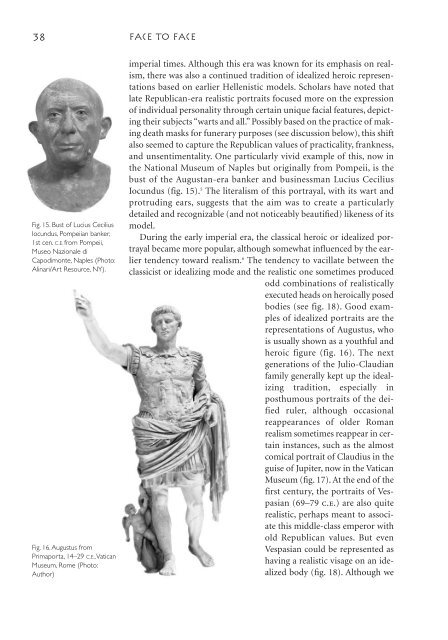You also want an ePaper? Increase the reach of your titles
YUMPU automatically turns print PDFs into web optimized ePapers that Google loves.
38<br />
Fig. 15. Bust of Lucius Cecilius<br />
Iocundus, Pompeiian banker,<br />
1st cen. C.E.from Pompeii,<br />
Museo Nazionale di<br />
Capodimonte, Naples (Pho<strong>to</strong>:<br />
Alinari/Art Resource, NY).<br />
Fig. 16. Augustus from<br />
Primaporta, 14–29 C.E.,Vatican<br />
Museum, Rome (Pho<strong>to</strong>:<br />
Author)<br />
Face <strong>to</strong> face<br />
imperial times. Although this era was known for its emphasis on realism,<br />
there was also a continued tradition of idealized heroic representations<br />
based on earlier Hellenistic models. Scholars have noted that<br />
late Republican-era realistic portraits focused more on the expression<br />
of individual personality through certain unique facial features, depicting<br />
their subjects “warts and all.” Possibly based on the practice of making<br />
death masks for funerary purposes (see discussion below), this shift<br />
also seemed <strong>to</strong> capture the Republican values of practicality, frankness,<br />
and unsentimentality. One particularly vivid example of this, now in<br />
the National Museum of Naples but originally from Pompeii, is the<br />
bust of the Augustan-era banker and businessman Lucius Cecilius<br />
Iocundus (fig. 15). 5 The literalism of this portrayal, with its wart and<br />
protruding ears, suggests that the aim was <strong>to</strong> create a particularly<br />
detailed and recognizable (and not noticeably beautified) likeness of its<br />
model.<br />
During the early imperial era, the classical heroic or idealized portrayal<br />
became more popular, although somewhat influenced by the earlier<br />
tendency <strong>to</strong>ward realism. 6 The tendency <strong>to</strong> vacillate between the<br />
classicist or idealizing mode and the realistic one sometimes produced<br />
odd combinations of realistically<br />
executed heads on heroically posed<br />
bodies (see fig. 18). Good examples<br />
of idealized portraits are the<br />
representations of Augustus, who<br />
is usually shown as a youthful and<br />
heroic figure (fig. 16). The next<br />
generations of the Julio-Claudian<br />
family generally kept up the idealizing<br />
tradition, especially in<br />
posthumous portraits of the deified<br />
ruler, although occasional<br />
reappearances of older Roman<br />
realism sometimes reappear in certain<br />
instances, such as the almost<br />
comical portrait of Claudius in the<br />
guise of Jupiter, now in the Vatican<br />
Museum (fig. 17). At the end of the<br />
first century, the portraits of Vespasian<br />
(69–79 c.e.) are also quite<br />
realistic, perhaps meant <strong>to</strong> associate<br />
this middle-class emperor with<br />
old Republican values. But even<br />
Vespasian could be represented as<br />
having a realistic visage on an idealized<br />
body (fig. 18). Although we


